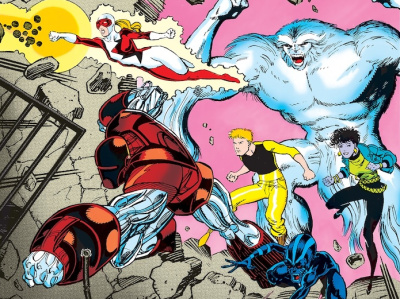One of the biggest fears I've heard from comic retailers I've interviewed since Diamond Comic Distributors filed for Chapter 11 bankruptcy protection in January has been the loss of the monthly data flow from Diamond, which listed products from hundreds of suppliers. Diamond wasn't just a one-stop shop for product, it was also a one-stop shop for data on upcoming products, bringing together information in a (mostly) consistent format that retailers could use to take orders from their customers and plan their monthly purchases.
"The impact that [a loss of] Diamond's going to have on most stores is the lack of data that's going to be available, that Diamond usually produced on a regular basis," was the way Phil Boyle of Florida chain Coliseum of Comics laid out the issue in an interview earlier this year. "Everything from weekly reorder lists to their initial data files that they put out for the Previews catalog, things like that. If all that goes away we've clearly lost one‑stop shopping for information. I don't know that anybody's going to be replacing that information."
From the retailer's perspective the key issue is getting the data so they can promote and then source the products for their customers. But that data reflects a pipeline of information that started with relationships that Diamond established over decades with suppliers that sometimes only occasionally had products for the comic store market, but knew where to go to sell them when they did. In the early years, it was more difficult and Diamond had to do more work to open new suppliers; over time, suppliers came to Diamond because they were known as the distributor to the channel. Replicating that data flow if Diamond's new owners decide to eliminate or reduce categories, or dramatically change how they distribute advance order data, is going to be extremely difficult, if not impossible.
"It's a really, really, really big problem that is a two‑level problem," Brian Hibbs of Comix Experience in San Francisco explained. "The first level is how do we, the retailer, ingest that information and that data so that we are able to order or sell those books in the first place.”
"Then the second question, which is as important, if not maybe more important, is how do we then communicate that down to our customers," he continued.
It's not just getting the information, it's whether that information comes or can be packaged in the monthly groupings in which fans and retailers are used to ordering. Book publishers that release graphic novels, for example, typically distribute information by season, with three seasons a year. So it's an issue not only to get the information, but also to have it in a way that matches ordering cycles.
"If it's not part of the cycle in which we think of ordering (which is the monthly cycle), if it's given to us on a three times a year basis, then things will slip and not be communicated properly," Hibbs said, noting that as a single-store operator, he does not have staff hours to spend collecting and massaging data into usable forms.
There are multiple POS systems, including ComicHub, Manage Comics, Diamond’s legacy system ComicSuite, and others, that retailers can use to handle the monthly data flow and take preorders from their customers. But even if they can get information directly from the many suppliers that Diamond has carried in the past, and it is in the correct cycle, it also needs to be in a digestible format.
"If there's one thing that I would let you to make the thing that I say in this report is, every publisher who is not Penguin Random House, Lunar, or Diamond has got to get on the Comet standard tomorrow,” Hibbs emphasized.
The Comet Standard was developed by comic retailer organization ComicsPRO, which has been working to get publishers to adopt it as their metadata format for the channel (see "Metadata Project Update").
"Not six weeks from now, not six months from now, they've got to figure out the Comet standard right away, because without us being able to input data correctly into our point of sale systems, we will never be able to sell the books that people are trying to put out," Hibbs said.
One bit of good news is that retailers are already seeing July Previews files (for September releases). The bad news is that the number of products listed is about a third smaller than the listings in the June Previews, likely reflecting the loss of Penguin Random House as a supplier (see "Diamond Will No Longer Distribute Marvel"), and perhaps others. Big changes in data flow are starting now.
Comic retailers have already figured out how to deal with three suppliers to get their major comic lines, but the question now is what Ad Populum does with the rest of the business. Can Ad Populum create a profitable business by aggregating those hundreds of suppliers that Diamond used to carry as secondary lines, but without the big volume titles to cover much of the overhead? If so, how? Will a monthly data file still be part of the picture?
Ad Populum has been quiet, so it's not clear where they're headed. But they paid a lot of money for the Diamond assets they acquired, so I'm hopeful that they have a plan to continue to distribute many of the products that Diamond has historically carried. Let's also hope they have a plan to maintain the data flow that goes with them.










